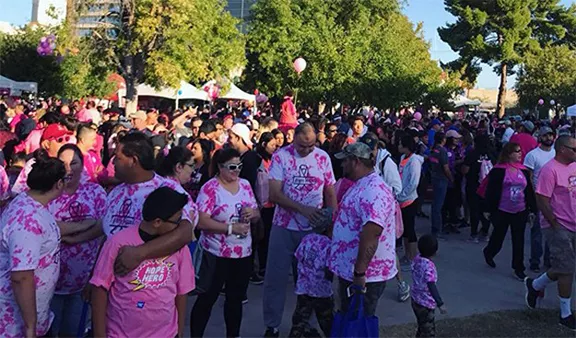Rain Man wins the Academy Award for Best Picture.
Janet Jackson's hit song "Miss You Much" spent four weeks at number one on the Billboard chart.
The San Francisco 49ers were Super Bowl Champions.
Gas cost only $1.06 a gallon.
And deaths from breast cancer were at their highest rate. Over the next three decades, the percentage of women dying from breast cancer would decline 40 percent.
That's the good news. Today, there are 3.5 million breast cancer survivors alive in the United States. Due to an increase in awareness, prevention methods, mammograms and free screenings, more women are surviving breast cancer than ever before!
The bad news is that breast cancer is the most commonly diagnosed cancer in women after skin cancer. It is the second leading cause of death caused by cancer after lung cancer. There is a one in eight chance a woman living in the United States will develop breast cancer in her lifetime. And in Arizona, an estimated 5,630 women will be diagnosed with breast cancer this year, and approximately 890 will die from the disease.
Early detection is vital when it comes to cancer. The sooner a cancer can be detected, the easier it is to treat and most likely to be curable. Although many women diagnosed with breast cancer have no symptoms, the most common symptom is a newly formed lump or mass. A painless, hard mass with irregular edges is more likely to be cancerous, breast cancers can also be tender, soft, or rounded, even painful. It is imperative to have any new breast mass, lump, or change checked by a health care professional experienced in diagnosing breast diseases.
The American Cancer Society recommends the following screening guidelines for women of average risk:
• Women between 40 and 44 have the choice to begin annual breast cancer screening with mammograms and should discuss this option with their doctor.
• Women between 45 and 54 should get mammograms every year.
• Women 55 and older should switch to mammograms every two years or can continue yearly screening. Screening should continue as long as a woman is in good health and is expected to live 10 more years or longer.
The ACS currently funds 162 research grants specifically targeting breast cancer, totaling more than $67 million dollars. Additionally, the American Cancer Society provides wigs to women facing a cancer diagnosis, free lodging if they need to travel to treatment, and peer-to-peer support from breast cancer survivors through our Reach To Recovery program. And when people have questions about cancer, we are available 24 hours a day, seven days a week, through our National Cancer Information Center. The American Cancer Society is committed to saving lives from the disease and making sure not only the death rate from breast cancer continues to decline, but that incidence rates are reduced as well.
Join us in the fight against breast cancer on Sunday, Oct. 20, at Armory Park for Making Strides Against Breast Cancer of Tucson. Funds raised through this noncompetitive, two-and-a-half-mile walk enable the American Cancer Society to save lives from breast cancer by investing in groundbreaking research; providing free, comprehensive information and support to those touched by the disease; and helping people take steps to reduce their breast cancer risk or find it early when it's most treatable.
Perhaps 30 years from now, we can reminisce about 2019—how Lil Nas X had the biggest song, maybe $2.97 for a gallon of gas will somehow sound inexpensive, Green Book won the Oscar, the New England Patriots won the Super Bowl (again), and it was the beginning of the end of breast cancer—a disease that is only a memory.








